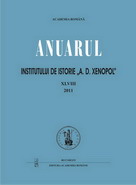Cu privire la problema editării unui „lexicon numismatic pentru Moldova (1359-1859)” (III)
ON THE EDITING OF A „MOLDAVIAN NUMISMATIC LEXICON (1359-1859)” (III)
Author(s): Viorel M. ButnariuSubject(s): History
Published by: Editura Academiei Române
Keywords: numismatic lexicon; laic and ecclesiastic sovereignties; laic and ecclesiastic authorities; mints; specific legislation; numismatists’ gallery
Summary/Abstract: For the research of the numismatic finds identified on the territory of Moldavia – country whose history is delimited by the beginning of the Golden Horde’s decline, together with the change of the local dynastic lineage by Bogdan who founded the voievodate of Moldavia, and, respectively, the union of the two Romanian principalities at mid 19th century – the specialist must use specific investigation means, such as numismatic text books, treatises and studies, usual determinators and collection catalogues, dictionaries and thematic lexicons. These work instruments were elaborated on the basis of the repertoire of numerous discoveries and the study of great numismatic collections from abroad. Unfortunately, Romanian historiography has been increasingly facing the need of a Repertoire of Numismatic Finds in the last decades. Whatever the epoch or the collections in which they are preserved, ancient, Byzantine, medieval or modern emissions are waiting for being published in a Corpus, which has not exceeded the project phase since almost half a century. Another absolutely necessary work instrument, in the form of a general encyclopedia, which would cover the whole numismatic spectrum of Romania, is The Romanian Numismatic Encyclopedia. This project was started decades ago by renowned specialists, who designed a plan, compiled a glossary and distributed the terms to each author. Like the Corpus, this encyclopedia has not evolved from the project phase. Throughout the years, the individual effort of several distinguished authors, although it proved to be beneficial, led to results which may rather assure a stimulating effect on those interested in such a topic. Undoubtedly, this is a regrettable situation caused not by the lack of sources, or by people’s unawareness as for their availability, but rather by the approach manner – such sources being especially dedicated to ancient coins – and also the communication manner of the available data – only rarely in international languages. Fortunately, time has brought about a considerable increase of the monetary finds, whose systematical valorization led lead to the dissemination of the specialized knowledge and the increase of the people interested in numismatics. As for us, our opinion is that both projects may become viable, as long as the current conditions are understood by those willing to implement such projects. First of all, one should take into account that the numismatic material of the great collections is currently being studied, and, recent discoveries which have only lately entered the numismatic collections of museums, are almost unknown or even not at all known. easily understandable reasons, during the last two decades we have narrowed down the investigation of the monetary finds to those identified on the territory of Moldavia, whose past is told, to a great extent, by two separate histories.
Journal: Anuarul Institutului de Istorie »A.D. Xenopol« - Iaşi
- Issue Year: XLIX/2012
- Issue No: 49
- Page Range: 375-408
- Page Count: 33
- Language: Miscellaneous languages

